During slavery, a slave owner could check in on his slaves and see how they were living (or he could rape them for that matter). Nowadays, consumers employ countless sweatshop workers in the global South and Asia, but have never seen them. These workers could be treated better or worse than slaves, but consumers wouldn’t know. Highly successful consumers are like overlords who have no idea what their minions do, how much they are paid, or how they are treated.
These overlords don’t delight in their power. If they think about their role at all, they see themselves as contributing to positive change, creating wealth, liberating women, and otherwise making things better for their minions. Corporations provide imagery to help form this narrative. If any reports of misery among the minions manage to reach the overlords, they have ready some comforting rhetoric, such as, “that’s the fault of their own governments, which are less democratic than ours.”
You may not feel you have yet reached the level of overlord, but any consumer can improve their lot, or at least imagine they can. Many join churches, sign up for multi-level marketing schemes, buy books, and read articles that advocate philosophies for being successful. Consumers are particularly attracted to enumerated lists. Chances are you’re already doing several of the things successful overlords all around you do every day.
1) Wear Clothes
There are people in Haiti and Bangladesh making your underpants. It’s an intimate, yet distant and anonymous relationship. In case consumers begin to have concerns about those making their clothes, certain words are written on labels to let them off the hook. Clothes made in a sweatshop might offer a consolation, such as “made in a zero-landfill facility,” “we contribute 1% of profits to charity,” “45% hemp,” or “certified organic cotton”.
2) Using Gas and Coal
Fuel consumption is part of every consumer’s life. Fuel is required to bring products to stores and parts to manufacturers, to power manufacturing, to grow food, to create pesticides, to build and power houses, to fly, etcetera. If the cost of fuel suddenly shot up, people would starve. Fuel usage powers climate change, which seems to be on track to destroy civilization. Also, fuel and crude oil leak, poisoning ecosystems and indigenous people who live near extraction sites.
Successful overlords have many options at their disposal for not feeling so guilty about fuel consumption, such as buying a hybrid car. They tell themselves that using less gas than other drivers is a big enough step in the right direction. Some ride a bus, or even a bike to work. Consumers generally ignore the other ways in which they depend on fuel use every day, and some even deny climate change.
3) Wipe Your Butt
80 million trees a year, and 30 billion pounds of greenhouse gases help consumers put off transitioning to cleaner and more ecologically friendly butthole waterjets. Everyone can agree that a hose would do a better job than paper at cleaning up pudding on the sidewalk, but when it comes to butts, overlords demand paper. Though it costs more, recycled toilet paper is popular because it has images of trees on the package.
4) Eat
Successful overlords shop at fancy grocery stores that feature products with elaborate labels that bring their attention towards positive attributes. Our food usually is prepared in sweatshops, uses extremely wasteful packaging, contains unhealthy quantities of sugar and salt, employs unsustainable farming practices, etc., but fancy brands can tout being made with “100% organic cane sugar,” or “label printed with 100% soy ink”. Overlords like things that are “100%”. These consolations help overlords imagine they are part of the solution.
50 billion pounds of meat each year goes through the intestines of Americans. With a diet flown and shipped in from around the world, successful overlords enjoy a diversity of tastes that no king of the ancient world could afford or imagine. Unfair treatment of workers, climate change, unsustainable use of water, and animal suffering are just the costs of doing business. Overlords don’t like to think about these things. They watch widescreen TVs during their meals to help focus their attention on entertainment and new products.
5) Use Widescreen HD TVs, Cell Phones, Tablets and Computers
Electronics are made by workers in terrible conditions. No electronics manufacturer even pretends that its devices are “fair trade”. Many also contain conflict minerals, which fund wars across Africa which kidnap and forcibly conscript child soldiers. Old electronics are dumped on whatever country will take them for the cheapest. The toxins can pollute the water and land of whoever lives nearby, and children are employed to pull them apart to harvest toxic valuable substances.
Since there is really nothing that can mitigate this messy impact, consumers elevate electronics beyond luxuries or even necessities. They become like spiritual objects. New product announcements become the topic of mystery and speculation. Sweatshop employer Steve Jobs becomes a visionary, an inspiration, a prophet who said:
The only way to do great work is to love what you do. If you haven’t found it yet, keep looking. Don’t settle. As with all matters of the heart, you’ll know when you find it. And, like any great relationship, it just gets better and better as the years roll on. So keep looking until you find it. Don’t settle.
This is his suggestion for overlords. In his Foxconn sweatshops, his minions receive a different set of instructions.
]]>They say you are what you eat, so I strive to eat healthy
My goal in life is not to be rich or wealthy
Cause true wealth comes from good health, and wise ways
We got to start taking better care of ourselves– Dead Prez, “Be Healthy“
Food can mean a number of things to different people. At the very base level, food means that stuff we ingest to fuel our metabolic processes — a gas station burrito, a packet of Funyuns, a drive-thru cheeseburger made of soy and corn syrup and pink slime and “meat glue.” In another context, it is the thing that brings together families and communities to sit and talk, trade stories, laugh, seek solace, allay concerns, and confer advice. In religious settings, bread can become the flesh of god and wine his blood and one woman’s sacred cow becomes another woman’s lunch (and don’t even get me started on “Ham N Eggs.”) The need for food can drive people to petty crime, such as minor thefts, or crimes against humanity — as Europe’s appetite for spices sparked imperialism, its need for sugar drove chattel slavery, and our “need” for bananas drove the US to do some pretty awful things in Central and South America. Some foods can make you ill, and some foods can act as medicine.
 So, “What is food? How do you define ‘food?'” are the perfect questions to kick off a panel discussion about food photography. Unfortunately, the baseline definitions that could have served as the foundation for a fruitful discussion centered around Houston Center for Photography’s recent exhibit, SEE FOOD: Contemporary Photography and the Ways We Eat, did not even get asked until the discussion was almost over — by an audience member, at that — after almost a full hour of meaningless conjecture and personal anecdotes about social media by local food industry insiders. (Here is a link to that a video of that talk, as well as a link to a panel discussion with the photographers, which, from what I understand, delves much deeper into the photographs and their implications; and for the record, this was a panel of qualified, talented, thoughtful professionals who very clearly show a high level of social awareness and do great work in the community, but for whatever reason, this discussion tended to stay at a very surface level. Big ups, in particular, to chef/restauranteur Monica Pope, Callie Hastings Easterly of Urban Harvest, PR pro and Food Bank volunteer Paula Murphy, and Jim Gossen of Sysco Louisiana Seafood.) You can see a slideshow of all the images in the exhibition here, which I do recommend, because I’m about to talk about them all right about now.
So, “What is food? How do you define ‘food?'” are the perfect questions to kick off a panel discussion about food photography. Unfortunately, the baseline definitions that could have served as the foundation for a fruitful discussion centered around Houston Center for Photography’s recent exhibit, SEE FOOD: Contemporary Photography and the Ways We Eat, did not even get asked until the discussion was almost over — by an audience member, at that — after almost a full hour of meaningless conjecture and personal anecdotes about social media by local food industry insiders. (Here is a link to that a video of that talk, as well as a link to a panel discussion with the photographers, which, from what I understand, delves much deeper into the photographs and their implications; and for the record, this was a panel of qualified, talented, thoughtful professionals who very clearly show a high level of social awareness and do great work in the community, but for whatever reason, this discussion tended to stay at a very surface level. Big ups, in particular, to chef/restauranteur Monica Pope, Callie Hastings Easterly of Urban Harvest, PR pro and Food Bank volunteer Paula Murphy, and Jim Gossen of Sysco Louisiana Seafood.) You can see a slideshow of all the images in the exhibition here, which I do recommend, because I’m about to talk about them all right about now.
It is always a shame when, at an art talk, people choose to talk about everything but the art, but in the context of this visually compelling, intellectually stimulating, emotionally engaging, morally challenging, politically relevant, spiritually resonant, and sometimes even humorous exhibition of photographs, it is almost tragic. When Brooke Sinclair of the Houston Food Bank pointed to Mark Menjivar’s photo of a refrigerator stuffed with Styrofoam takeout containers and said, “That’s what my fridge looks like,” I wish somebody had taken a moment to pause and ask, “And what does that say about you, and the society we live in?”
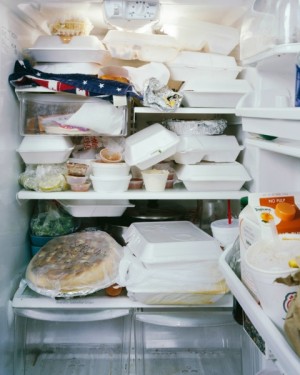
Mark Menjivar (San Antonio, TX), Bartender, 2025.
From the series You Are What You Eat, courtesy of the artist.
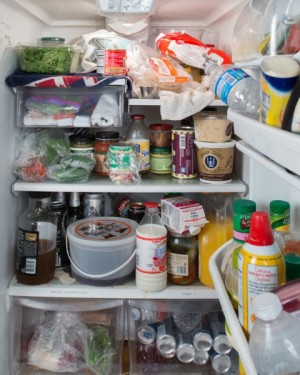
Mark Menjivar (San Antonio, TX), Bartender, 2025.
From the series You Are What You Eat, courtesy of the artist.
Menjivar’s series, You Are What You Eat, presents four pairs of “portraits,” taken of the same subjects’ refrigerators, four years apart. He writes on his website:
You Are What You Eat is a series of portraits made by examining the interiors of refrigerators in homes across the United States…A refrigerator is both a private and a shared space. One person likened the question, “May I photograph the interior of your fridge?” to asking someone to pose nude for the camera.
Each fridge is photographed “as is”. Nothing added, nothing taken away.
These are portraits of the rich and the poor. Vegetarians, Republicans, members of the NRA, those left out, the under appreciated, former POWs, dreamers, and so much more. We never know the full story of one’s life.
My hope is that we will think deeply about how we care.
How we care for our bodies. How we care for others. And how we care for the land.
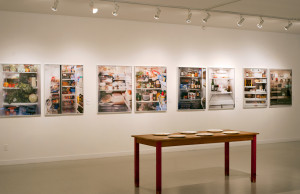
Mark Menjivar (San Antonio, TX), Installation view of series You are What You Eat, 2025 & 2025.
Courtesy of HCP
What would your fridge look like? What does that say about you? (I am a single man who lives alone — it rarely makes sense for me, time- and money-wise — to cook for myself, unless I am cooking large batches and eating leftovers all week. That is one thing that my refrigerator would say.) (It might also betray the fact that I have a serious weakness for the dairy aisle at Phoenicia.)
Houston-based Emily Sloan also played with a refrigerator and its strange location somewhere in between the private and the public. Sloan brought out Box 13‘s Kenmore nanogallery (it’s a mini-fridge) with these instructions for the audience:
Confessions are requested from the public.
Use a recipe card to describe a food act you typically perform secretly or in private.
Place the recipe card in the can of coffee within The Kenmore.
The owner of The Kenmore will select acts at random, recreate and photograph the selected pieces. The new photos will be displayed on The Kenmore.
Sloan’s installation (click to enlarge the photos) depicts people licking plates, drinking straight from the carton, spraying whipped cream right into the mouth, and mimicking dirty deeds with vegetables. Viewers’ private “confessions” are performed by the artist, then documentation of that performance is displayed in the very public way that families display images in their private domestic setting (home kitchen). The guilt and repression implied by “confessing” “guilty pleasures” reminds viewers that control over uncontrollable appetites and “pleasures of the flesh” have long been a tool of social programming — there’s nothing like prohibiting something to make it more enticing, and there’s nothing like the attendant guilt to make people fall in line.
Another Houston photographer, Emily Peacock, playfully raises the question with which we started — What is food? — with her abstract, whimsical photographs of highly processed “food products.”
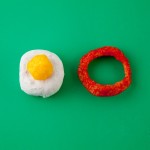
Emily Peacock (Houston, TX)
Whiskey Tango #4, 2025/2013
From the series Whiskey Tango
Courtesy of the artist
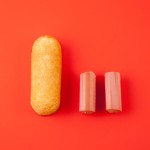
Emily Peacock (Houston, TX)
Whiskey Tango #3, 2025/2013
From the series Whiskey Tango
Courtesy of the artist
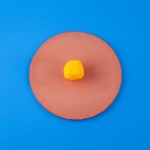
Emily Peacock (Houston, TX)
Whiskey Tango #1, 2025/2013
From the series Whiskey Tango
Courtesy of the artist
“What the hell is that?” the viewer is forced to ask, looking at odd colored circles and spheres against bright backgrounds. The question works on many levels: first, looking at an image of a cheese puff on top of a slice of bologna, the viewer has to figure out that it is indeed a cheese puff on top of a slice of ham, but that then begs the questions, “What the hell is a cheese puff? What goes in them? What is taken out of whole foods to make these processed things? How do they make that color? Are there any harmful byproducts? Are the workers in the factory treated well? And what does this do to my insides?”
Jonathan Blaustein’s 2025 series “The Value of a Dollar” illustrates the food purchasing power of one dollar. ($1 ≠ very much saffron, btw.)
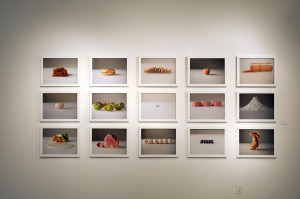
Jonathan Blaustein (Arroyo Hondo, NM), installation view of series The Value of a Dollar, 2025.
Courtesy of HCP
Blaustien photographs one dollar’s worth of (L-R): (top row) pork floss, double cheeseburger from McDonald’s, dried smelt, peach from the farmer’s market, and Shurfine white bread; (middle row) one dollar’s worth of local duck egg from the farmer’s market, tomatillos from Mexico, saffron, potted meat food product, and Shurfine flour; (bottom row) one dollar’s worth of side salad with ranch dressing from Burger King, beef shank from Supersave, chicken eggs from a factory farm in Texas, early season organic blueberries from California, and fried pig skin. (The man is clearly paying way too much for his chicharrones, btw.)
In her series “Britain’s Dinners,” British ceramist Damaris Booth prints photographs of meals onto dinner plates, adding an element of kitsch that renders banal the implications of the series title and choices of cuisines depicted. That “Pizza,” “Curry,” and “Chinese,” can be considered as British as “Roast Dinner,” “Fish ‘n’ Chips,” and “Bangers ‘n’ Mash,” and the fact that this consensus is pervasive enough to appear on a (conceivably mass-produced) consumer product you might pick up at Target or even a Dollar Store says much about colonialism, trade, migration, multiculturalism, and national identity.
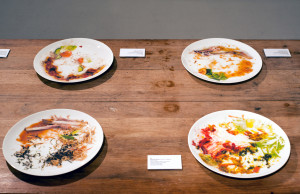
Damaris Booth (London, England), installation view of series Britain’s Dinners, 2025.
Courtesy of HCP
Andrzej Maciejewski does something similar in his soft-focus photo still-lifes — he subverts the familiar (almost kitschy) form of the traditional still life, a form which shows off the painter’s talent by “elevating” a banal subject in order to emphasize technique and color harmony.

Andrzej Maciejewski (Ontario, Canada)
Still Life with 4030(New Zealand), 4927(Italy), 4940(USA), 3127(Mexico), 4433(Panama) and 4958(Mexico)
24 x 30 inches, Archival pigment print
From the series Garden of Eden
What the old masters did with oil paints, however, Maciejewski does with machines (camera, computer, printer), and his titles are as hilarious as his photos are beautifully composed, focused, printed. By leaving the tags, stickers, brands, and bar codes of mass-market global commerce on these living objects made of soil and water and sunshine, Maciejewski forces the viewer to acknowledge her disconnect from nature and the ecological unsustainability — not to mention inferiority in both taste and nutritional value — of this petroleum-heavy corporate food production and distribution system. These are not fruits and vegetables, these are “agricultural products,” and the viewer is not a “human,” is not a living, breathing participant in a living, breathing ecosystem, but is a “consumer,” instead.
But this is just half the exhibit. There may be hope, yet! Anchoring (or grounding, rather) what might be viewed as the other half of the exhibit is an actual garden, by local (by way of Vancouver) artist, educator, and gardner Brett Sillers.
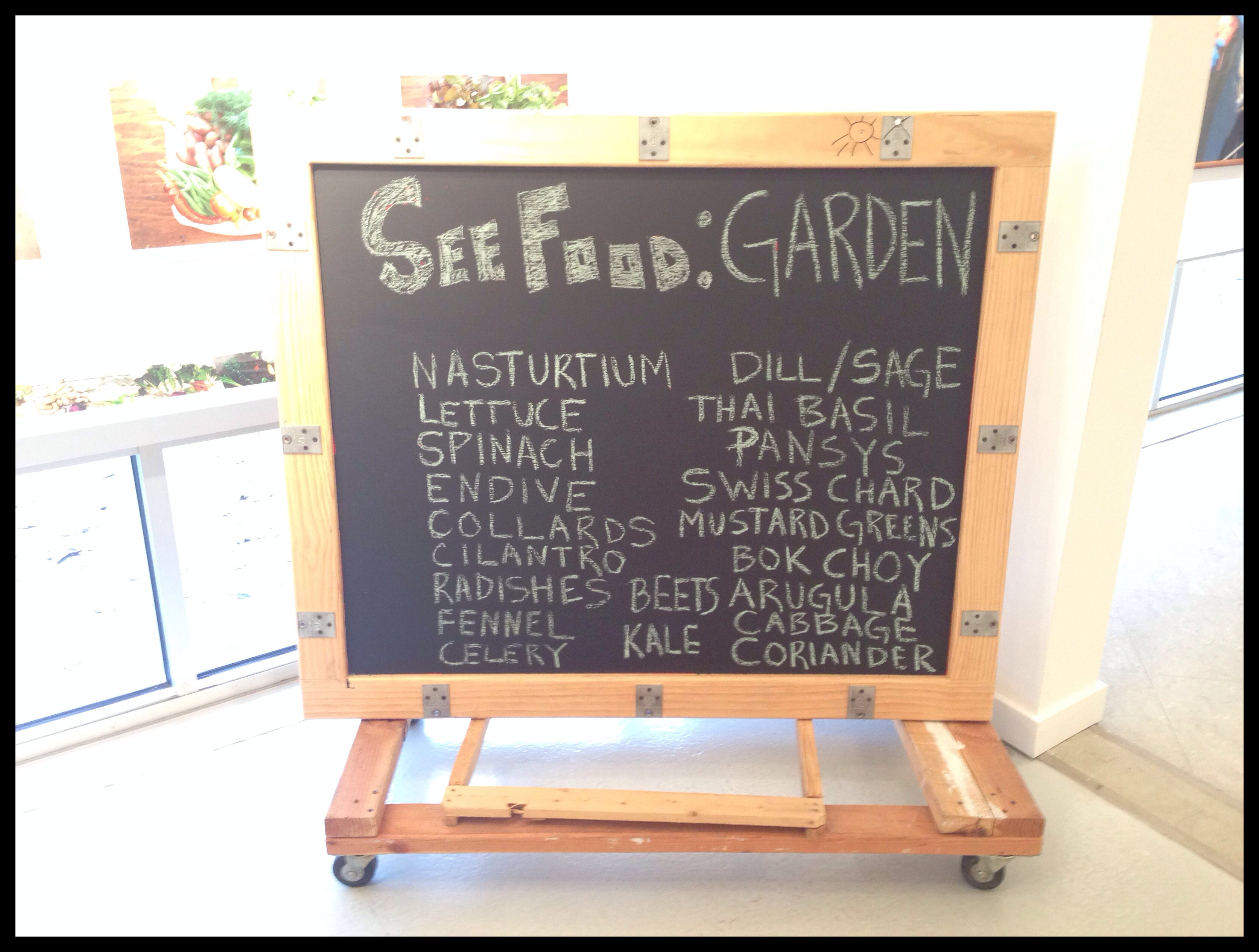

Behind Sillers’s lush, thriving containerful of vitality looms Nolan Calisch’s series of photographs of weekly “food shares” from three different Community Supported Agriculture co-ops (or CSAs) in Brenham, Portland, and Fairbanks, Alaska. CSAs have been gaining popularity over the past decade, and provide a way for small-scale farmers to connect with urban “consumers” in a symbiotic relationship that seems much healthier and more sustainable than big time agribusiness. The photos, taken weekly over a six-week period, depict the changing seasons through their bountiful harvests, and in a stark contrast to Emily Peacock’s photographs of highly refined and processed “food products,” the veggies show traces of the soil that produced them. Even the arrangement of the vegetables — on reusable tote bags and cloth blankets spread right on the earth they are made from — suggests wholesome strength, vitality, and fertility. The viewer can smell the rich soil, and prints of the photographs are displayed near the bottom of the installation in a way that resembles seed packet displays, and, in a gesture that points to the Earth’s abundance as depicted in the photos, viewers are invited to take a photo print — a seed to plant in her consciousness, to guide her own feeding choices.
The second gallery is all images from the production side of the food industry — “the farm, field, and sea.” Corey Arnold’s documentary photos of commercial fishing show dramatic scenes of “man vs nature” in visibly harsh environments.
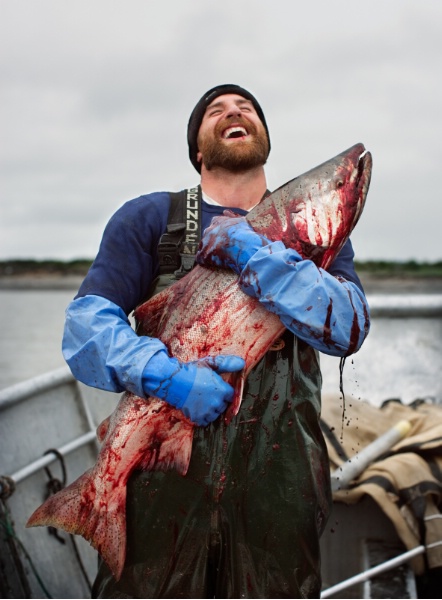
Corey Arnold (Portland, OR), Ben and King, 2025.
40 x 30 inches, Chromira C-Print
From the series Fish Work, Courtesy of the artist and Charles A. Hartman Fine Art.
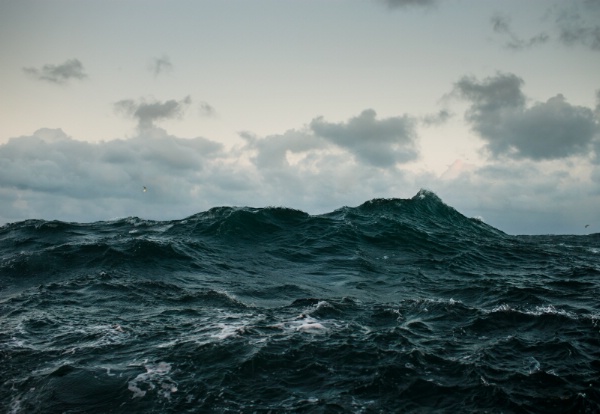
Corey Arnold (Portland, OR), The North Sea, 2025.
20 x 29 inches, Chromira C-Print
From the series Fish-Work: Europe
Courtesy of the artist and Charles A. Hartman Fine Art
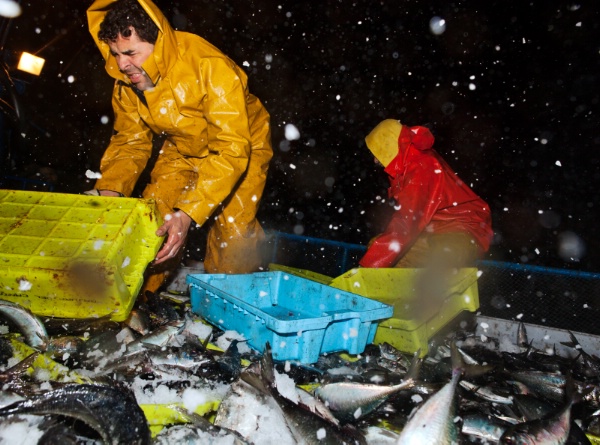
Corey Arnold (Portland, OR), Horse Mackerel Assault, 2025
20 x 27 inches, Chromira C-Print
From the series Fish-Work: Europe
Courtesy of the artist and Charles A. Hartman Fine Art
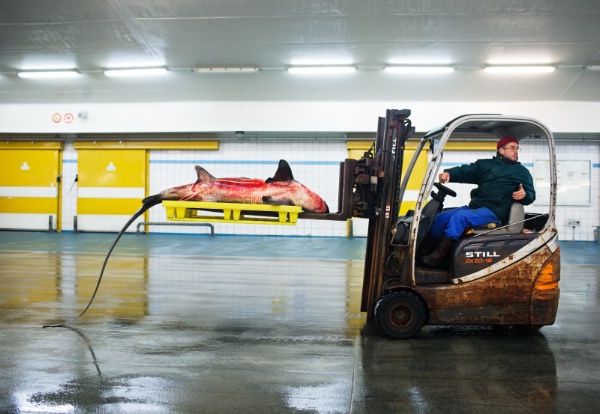
Corey Arnold (Portland, OR), Positive Bycatch, 2025
20 x 27 inches, Chromira C-Print
From the series Fish-Work: Europe
Courtesy of the artist and Charles A. Hartman Fine Art

Corey Arnold (Portland, OR)
Opilio Bed, 2025
20 x 27 inches
Chromira C-Print
From the series Fish-Work: The Bering Sea
Courtesy of the artist and Charles A. Hartman Fine Art
Christine Boggs’s series showing co-ops in the Rochester, NY area includes an image of a bakery owner (or manager) crunching numbers during early morning or late night hours, trying to make ends meet. Another photo from the same series shows a pile of discarded gardening gloves, some bearing images of Dora the Explorer and calling migrant farm workers — and their own and their children’s relationship to Dora — to the viewer’s mind.
David Welch’s photo of chickens being drained of their lifeblood in inverted traffic cones come from a world where meat glue is only a nightmare, not a reality, and Jody Horton’s cookbook photos of oyster gathering remind the viewer that the oysters served on ice with a side of horseradish and hot sauce in their Instagram “feed” come from men, knee deep in marshes with sweat stinging their eyes.
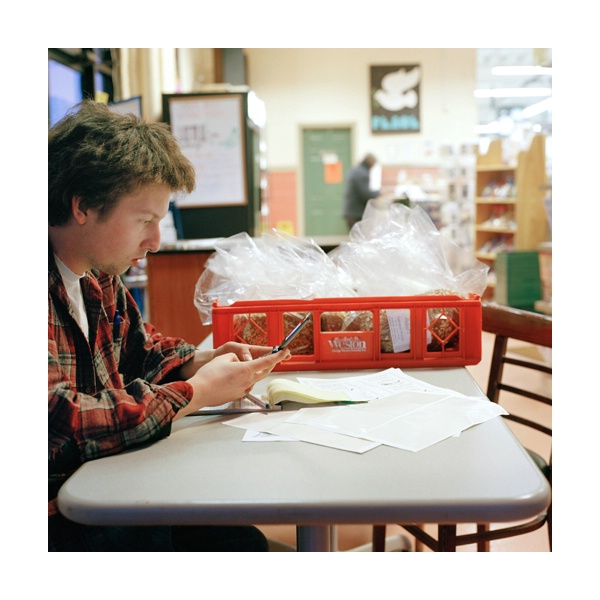
Christin Boggs (Washington DC), Eli, Small World Bakery, 2025
20 x 20 inches, Archival inkjet print
From the series Slow and Steady, Courtesy of the artist
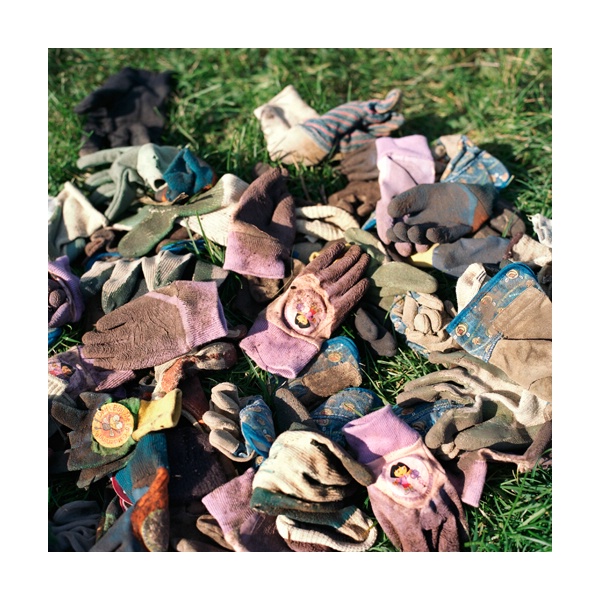
Christin Boggs (Washington DC), Dora the Explorer, Rochester Roots, 2025
20 x 20 inches, Archival inkjet print
From the series Slow and Steady, Courtesy of the Artist
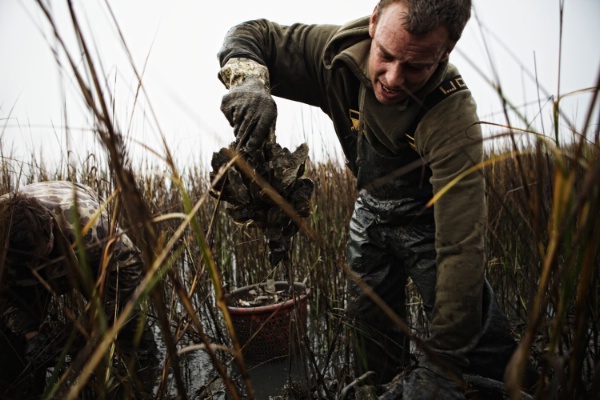
Jody Horton (Austin, TX), Oyster Pickers 2, 2025
24 x 30 inches, Inkjet print
From the series Oyster Picking, Courtesy of the artist
But back to the question — what does Mark Menjivar’s portrait of a person with a fridge full of styrofoam containers say about that person and us, as a society? Answers to this question did come up, albeit indirectly, during the panel discussion on January 7.
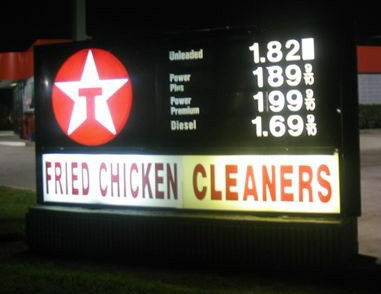 We are a society so overworked and underpaid that taking time to cook our own meals from scratch, let alone shop for the ingredients, let alone cultivate those ingredients ourselves, has become a luxury. We are a society where many have too little because a few have too much — and rather than challenge that injustice at its root, we content ourselves with palliative donations to food banks and other charities, that is, we prefer charity to justice. We are a society that is more likely to consider food a type a fuel — equating eating to gassing up a car — than a social or a spiritual activity. We are lonely and isolated and completely divorced from the soil beneath our feet, but there is hope. Pass the cheese puffs.
We are a society so overworked and underpaid that taking time to cook our own meals from scratch, let alone shop for the ingredients, let alone cultivate those ingredients ourselves, has become a luxury. We are a society where many have too little because a few have too much — and rather than challenge that injustice at its root, we content ourselves with palliative donations to food banks and other charities, that is, we prefer charity to justice. We are a society that is more likely to consider food a type a fuel — equating eating to gassing up a car — than a social or a spiritual activity. We are lonely and isolated and completely divorced from the soil beneath our feet, but there is hope. Pass the cheese puffs.
Harbeer Sandhu is not only a staff writer for Free Press Houston but also publishes the Houston-based art blog Texphrastic, which is A Project of the Creative Capital | Warhol Foundation Arts Writers Grant Program. For all his bluster, you might check out one of the first things he wrote for FPH: a review of a restaurant at a gas station.
When Brooke Sinclair of the Houston Food Bank pointed to Mark Menjivar’s photo of a refrigerator stuffed with Styrofoam takeout containers and said, “That’s what my fridge looks like,” I wish somebody had taken a moment to pause and ask, “And what does that say about you, and the society we live in?”
]]>


